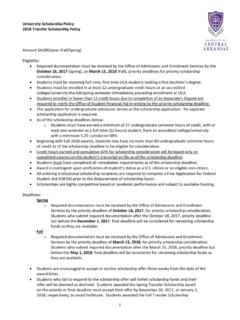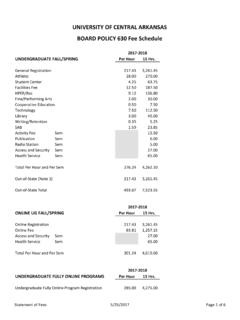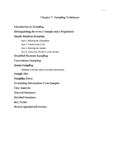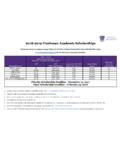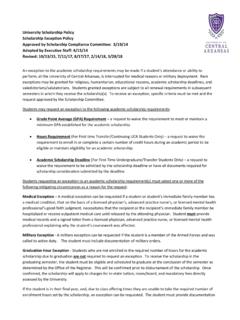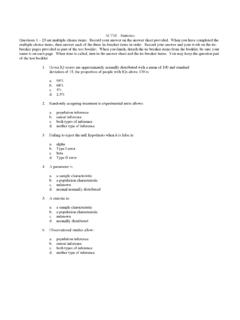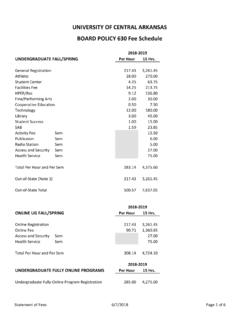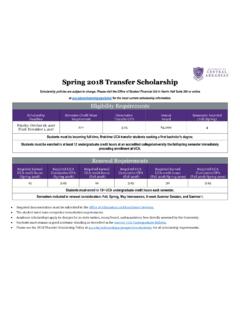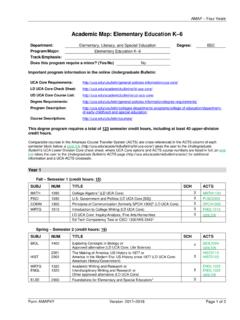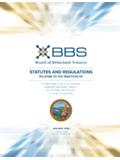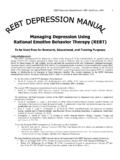Transcription of Importance of Correlational Research Addressing ...
1 15 - 1 Chapter 15. Nonexperimental Research Designs: Correlational Design, Ex Post Facto Design, Naturalistic Observation, and Qualitative ResearchIntroduction to Nonexperimental DesignsCorrelational DesignImportance of Correlational ResearchDirection of Control and Third Variable ProblemsAddressing Directionality and Third Variable ProblemsCorrelational Ruling Out FactorsInterpretation of Correlational DataEx Post Facto DesignNaturalistic ObservationQualitative ResearchCase StudyPhenomenologyEthnographyCase AnalysisGeneral SummaryDetailed SummaryKey Terms Review Questions/Exercises15 - 2 Introduction to Nonexperimental DesignsWe have said much about true experiments and we have described their strength in drawing strong, confident conclusions.
2 A word of caution is advisable. An experiment may use random assignment and involve manipulation of the treatment variable and still be essentially worthless as a basis for drawing conclusions. It is essential that rigorous controls, careful execution, planning, thoughtfulness, etc., accompany a valid design. We have also noted the qualities of designs termed quasi-experimental. Recall that these were characterized as designs in which the independent variable was manipulated but the study lacked random assignment of participants to we have seen thus far in the book, experimental Research is a very powerful tool for generating a scientific database for drawing cause-effect conclusions, for testing hypotheses and evaluating theory, for answering questions and satisfying our intellectual curiosity, for systematic manipulation of variables, and, at times, for discovering principles that may be relevant to everyday life.
3 After considerable discussion of the virtues of experimental designs, you might wonder why researchers would use other types of nonexperimental designs. Actually, there are several good reasons to use nonexperimental designs. Many very interesting questions in psychology do not lend themselves to experimental designs. Some of thesequestions involve independent variables that simply cannot be manipulated by a researcher. If we wish to study the effects on a dependent measure of such naturally occurring variables as gender, ethnic background, intelligence, temperament, or body size, we cannot say to the participants, "For the purposes of this experiment, I am going to declare you a female, or a black, or a person with an IQ of 130!
4 In addition, some questions involve independent variables that could theoretically be manipulated by aresearcher but are not because the opportunity does not present itself, the financial cost would be too high, or the ethical concerns too great. For example, we may ask, "Do individuals who have left hemispheric brain damage show greater verbal impairmentthan those who have comparable damage to the right hemisphere?" Obviously, it is not possible to randomly assign people to an experimental and control group and then conduct brain surgery to answer this question. However, if we are to shed any light on the question, we are forced to look into the histories of people who have suffered brain damage as a result of adverse circumstances.
5 Similarly, as we have repeatedly explored the issue of TV violence and aggressive behavior in children, we would certainly be interested in the effects of long-term (in terms of years) exposure to TV violence. I m sure that you can see the ethical issues involved in randomly assigning a group of children to watch violent television for several years!Thus, although nonexperimental Research designs are not as powerful as experimental designs , do not rule out as many alternative hypothesis (explanations), they provide us with options for pursuing 15 - 3interesting and important questions when experimental designs are not available. Figure provides an overview of the nonexperimental designs discussed in this chapter.
6 Let s explore some of these Overview of nonexperimental Research methodsCorrelational DesignAs noted, there are ethical issues involved in an experimental study to assess the long-term effects of TVviolence on aggressive behavior in children. However, we suspect that you can imagine a nonexperimental study that could assess the relationship between these two variables over the timespanof several years. Using either a retrospective technique (examine data that already exist) or a prospective technique (collect data across several years), you could record the degree of exposure to TV violence and the number of aggressive incidents. Correlational Research involves collecting data or searching out records of a specified population and ascertaining the relationships among the variables of interest.
7 Such Research involves neither random assignment nor manipulation of an experimental two Research procedures encountered most frequently, and also most sharply contrasted with each other, are the experimental and Correlational ones. Again, we repeat the important differences between them. The experimental approach studies the causal relationship between manipulated variables and uses random assignment (or repeated measures), whereas the Correlational approach studies the relationship between unmanipulated variables and does not use random assignment. Other examples of this approachare: smoking history and health problems; alcohol use and GPA; education attained and salary levels, etc. We view these Research methods as complementary techniques rather than competing ones.
8 As you shall see, they often serve different purposes and provide answers to different - 4 Random assignment of participants and the manipulation of variables are absent in Correlational Research because the events of interest have already occurred or are naturally occurring. The interest is in determining how measures on one variable are related to measures on another variable. Often, in psychology, the two measuresarebehavioral Correlational approach is sometimes referred to as the study of individual differences because emphasis is placed on differences among individuals. For example, assume that we have a distribution of individual scores on one measure (Intelligence Test Scores Test 1) and a distribution of individual scores on another measure (Final Exam Scores Test 2).
9 The question asked of these data by a Correlational approach is whether differences among individual scores on one variable (Test 1) are related to differences among individual scores on the other variable (Test 2).A statistical procedure called Correlational analysis is used to ascertain the extent of the relationship among individual scores on the two variables (tests). This emphasis on individual differences contrasts with an experimental approach where interest is in comparing the average performance of a group in one condition with the average performance of a group in another condition (single-subject designs are an exception).As you may recall from your introductory statistics course, calculating a correlation between two distributions of scores (scores on Test 1and scores on Test 2) results in a number called a correlation coefficient.
10 The strength of the relationship is indicated by the numerical value of the coefficient and its direction is indicated by a + or - sign. If the individual scores are unrelated (no relationship), the numerical value of the coefficient is 0; if the scores are perfectly related on the two distributions, the numerical value is either a or a + Thus the numerical value of the correlation coefficient may range from a to 0 or from 0 to a + , with variations in between. A positive relationship indicates that individuals scoring high on one distribution also tend to score high on the other distribution and that those scoring low on one tend to score low on the other. Put more simply, as individual scores on one distribution increase, their scores on the other increase ( , the more one studies, the higher one s grade point average).

